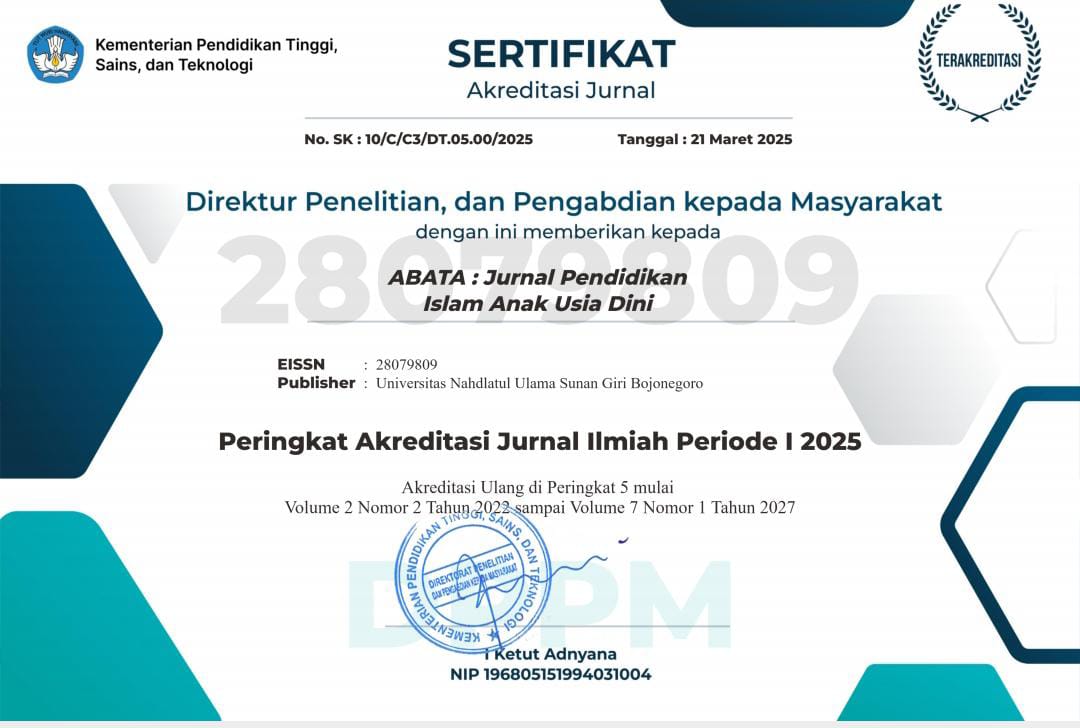UPAYA MENINGKATKAN KEMAMPUAN BERBAHASA ANAK DALAM BERCERITA MELALUI METODE TANYA JAWAB USIA 2-4 TAHUN
 pdf Download: 924
pdf Download: 924
DOI:
https://doi.org/10.32665/abata.v2i2.556Keywords:
Language skills, , storytelling, Question and answer methodAbstract
Abstract in English This study aims to improve children’s ability to tell stories through the question and answer method. Not all children can give a response when the storytelling process takes places and not all children are able to convey the meaning of their words well. The purpose of this study to determine the improvement of language skills through storytelling activities through the question and answer method. This study uses the class action research method. The research was conducted in a series of 2 recurring cycles, namely cycle I and cycle II. The four main activities that exist in each cycle are planning, implementation, observation, reflection. Prasiklus data as the foundation of awlany is only 35%. The results of this study indicate an increase in the success of the average percentage in the first cycle of RPPH I is 52,67% increased in the second cycle of RPPH 5 to 78,75% so that the application of storytelling activities with question and answer method can improve children’s language skills exceed the indicator of success that is ≥.76%. The conclusion of this study is that storytelling activities through the question and answer method are able to improve the language skills of the chidren aged 2-4 years at KB Budi Mulia Kediri.
References
Arikunto, S. (2019). Prosedur Penelitian Suatu Pendekatan Praktik. Rineka Cipta.
Cahyani, N. B., & Arif, Z. (n.d.). Upaya Mengenalkan Asmaul Husna Melalui Metode Bercerita Pada Anak Usia Dini.
Chaer, A. (2014). Linguistik Umum. Rineka Cipta.
Hamzah, N. (2020). Pengembangan Sosial Anak Usia Dini. Iain Pontianak Press.
Hasanah, U., Nasyikhah, D., & Khoiriah, U. S. (2019). Potensi Kecerdasan Linguistik pada Anak Usia Dini melalui Mendongeng Di Rumah Baca Madina Kota Metro. Al-Hikmah : Indonesian Journal of Early Childhood Islamic Education, 3(1), 16–26. https://doi.org/10.35896/ijecie.v3i1.39
Hazwani, M., Pahrul, Y., & Fauziddin, M. (2021). Optimalisasi Kemampuan Berbicara dengan Metode Berbicara pada Anak Usia Dini. Jurnal Pelita PAUD, 6(1), 135–140.
Maryana, M., Yusria, Y., & Riyanti, I. (2022). Penerapan Metode Bercerita Dalam Peningkatan Kemampuan Berbahasa Anak Usia Dini Dl Taman Kanak-Kanak Kasih Bunda Desa Batu Ampar Kecamatan Pauh Kabupaten Sarolangun [PhD Thesis]. UIN Sulthan Thaha Saifuddin Jambi.
Ni’mah, R., & Muntamah, S. (2021, September 23). View Of Pengenalan Angka Anak Melalui Media Balok Warna Di Ra Nurul Ummah. https://journal.unugiri.ac.id/index.php/abata/article/view/235/195
Nurwahyuni, E., & Mahyuddin, N. (2021). Penilaian perkembangan bahasa anak usia dini umur 5-6 tahun pada masa new normal di taman kanak-kanak ridhotullah padang. Jurnal cikal cendekia, 2(1).
Octivasari, F., & Nasriah, N. (2021). Pengaruh Mendongeng Terhadap Keterampilan Menyimak Pada Anak Usia 5-6 Tahun di TK Ibnu AL–Akbar Kecamatan Beringin Kabupaten Deli Serdang. Jurnal Bunga Rampai Usia Emas, 6(1), 14–19.
Puspitasari, E., Nurkholishoh, S., & Choiro, U. D. (2022). Peran permainan tradisional bakiak dalam meningkatkan kemampuan motorik kasar anak usia 3-4 tahun. Abata : Jurnal Pendidikan Islam Anak Usia Dini, 2(1), 142–152. https://doi.org/10.32665/abata.v2i1.340
Sugiyono, S. (2019). Metodologi Penelitian Kualitatif Kuantitatif dan R&D. Cv. Alfabeta.
Susanto, A. (2012). Perkembangan anak usia dini. Prenada Media Group.
Zulaika, A. (2021). Meningkatkan Kemampuan Berbicara Melalui Media Big Book pada Anak Usia Dini di Paud Darul Fathonah Kecamatan Medan Marelan [PhD Thesis].
Downloads
Published
Issue
Section
License
Copyright (c) 2022 Abata : Jurnal Pendidikan Islam Anak Usia Dini

This work is licensed under a Creative Commons Attribution 4.0 International License.
 pdf Download: 924
pdf Download: 924












